#collector turtle fossil
Explore tagged Tumblr posts
Photo

Trionyx Fossil Turtle Shell – Eocene Barton Beds Hampshire UK, Genuine Softshell Turtle Fossil
An exceptional and rare Trionyx fossil turtle shell discovered in the Barton Formation (Barton Beds), dating to the Eocene Epoch (~40 million years ago). This impressive specimen was collected by our dedicated fossil team members Alister and Alison on 08 June 2024 from Barton-on-Sea, Hampshire, and has been professionally cleaned, prepped, and treated by Alison.
Trionyx is a genus of extinct softshell turtles within the family Trionychidae, known for their leathery shells and aquatic adaptations. Their fossils are rarely found complete, making this partial shell specimen a significant and highly desirable piece.
Fossil Type: Turtle Shell (Reptile – Trionychidae)
Genus: Trionyx
Geological Age: Eocene – Bartonian Stage
Formation: Barton Formation (Barton Clay)
Depositional Environment: The Barton Beds were laid down in a shallow, subtropical marine to marginal marine environment with estuarine influence. These coastal systems were rich in life and conducive to the preservation of both marine and nearshore vertebrates.
Morphological Features:
Flattened carapace (shell) fragments typical of softshell turtles
Possible preserved margin or plastron elements
Mineralised bone texture visible under close inspection
Notable:
Rare Eocene turtle fossil from a classic British fossil site
Discovered and prepared by our own team with full provenance
Ideal for collectors, display, or educational use
The exact specimen shown is the one you will receive
Authenticity: All of our fossils are 100% genuine natural specimens and come with a Certificate of Authenticity. The scale cube in the image equals 1cm – please refer to the photo for full sizing.
This Trionyx fossil turtle shell from the Eocene of Barton-on-Sea offers a rare and scientifically valuable glimpse into the reptilian life of Britain’s ancient coastal environments. A standout piece for collectors and fossil enthusiasts.
#Trionyx fossil#fossil turtle shell#Barton-on-Sea fossil#Eocene turtle fossil#Barton Formation fossil#Hampshire fossil turtle#softshell turtle fossil#Trionychidae fossil#fossil reptile shell#UK Eocene fossil#genuine fossil turtle#collector turtle fossil#fossil reptile UK
0 notes
Text
Fossil Friday: Eremotherium

Eremotherium, the Wandering Ground Sloth or Pan-American Ground Sloth, lived in southern North America, Central America and northern South America from the Pliocene Epoch about 5 Ma to possibly the early Holocene Epoch (the current epoch we are in).

It was discovered in Skidway, Georgia in 1823 by fossil collectors J.P. Scriven ad Joseph C. Habersham, described by Joseph Leidy in 1855, and mistaken for Megatherium until 1948 when Franz Spillmann recognized it for a new genus and named it Eremotherium.

Because the rocks it is found in are so young, it was very difficult to find any information on formations. A lot are just unconsolidated sediments that haven't been buried long enough to be properly turned into rock yet. Wild to think about. Old enough to fossilize bone but not old enough to make a rock. One of the biggest localities for finding Eremotherium is in Florida in a karst site (limestone that has undergone dissolution producing a rugged landscape of sinkholes, ridges, and fissures) filled with unconsolidated clay where an old Pleistocene lake used to be.

Eremotherium lived alongside very familiar animals like Trachemy platymarginata, a pond turtle,
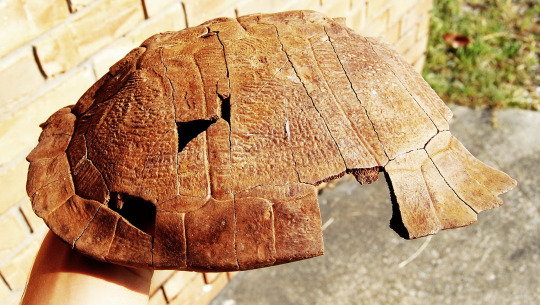
Holmesina floridanus, a giant armadillo,
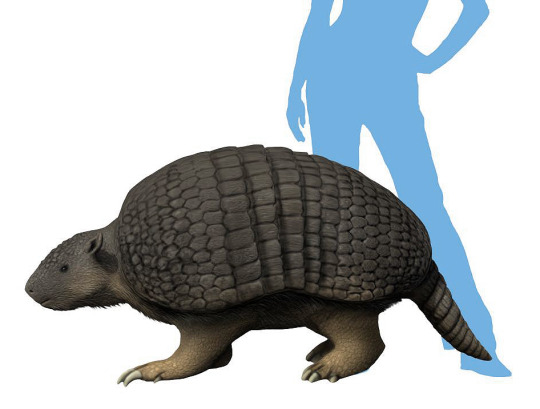
Tapirus lundeliusi, a tapir,

Chelydra, a snapping turtle,

Erethizon poyeri, a porcupine,

and Amplibuteo concordus, an eagle,

as well as many other animals including an alligator species in Florida. In Brazil, it was living with more unfamiliar animals such as Toxodon platensis,
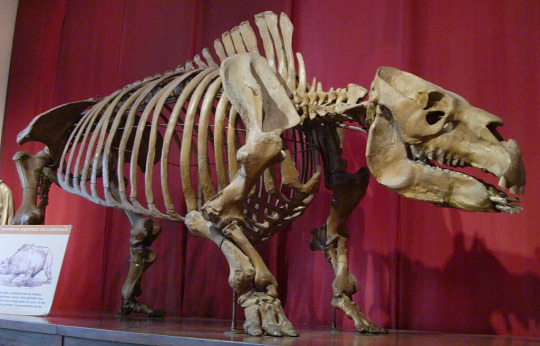
Glytotherium,

Panochthus,

as well as a few armadillos.

Eremotherium is part of the class Mammalia, the clade Eutheria, the superorder Xenarthra, the order Pliosa, the clade Megatheria, the family Megatheriidae and the subfamily Megatheriinae. There are two species of Eremotherium, E. eomigrans and E. laurillardi.

It's closest living relative is the Three-toed Sloth.

Eremotherium was 20 ft (6m) long, about 6.6 ft (2m) tall on all fours and 13 ft (4m) tall when rearing. The most recent estimates have it weighing in at 6, 931 lbs. (3,144 kg).

It's skull measured 25.6 in (65cm) in length and was close to 13 in (33cm) wide at the zygomatic arches (bones that go from the temples, around the eye socket toward the upper jaw bone). It had a shortened nasal bone (nose) giving it a sort of truncated cone appearance and it had small, shallow eye sockets that sat slightly lower than its relatives. The teeth of Eremotherium are large, rectangular when viewed occlusally, and have a unique v-shaped valley in lateral view. Both species had 5 upper and 4 lower teeth in each side of the jaw, with upper and lower crowns interlocking along the V-shaped valleys into what was likely a shearing surface for processing leaves and small branches

The vertebrae were massively built but also compressed anterior-posteriorly giving it a shortened look overall especially in the tail.


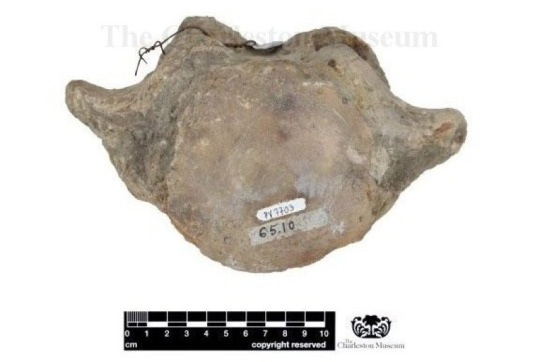
They have very robust limb bones to carry their immense weight. look at these beefy bones!

The two species had a different number of digits on their hands with E. eomigrans having five digits and E. laurillardi having only three.


Eremotherium primarily moved on all fours with its feet turned inward, its weight resting on the outer phalanges. This all suggests it was pretty slow. Shocker, a slow sloth? Who would have guessed? It's hands were not properly shaped for digging as once thought due to its large claws but the fingers had limited mobility that would have made this endeavor impossible. However, it was able to rear on its hind legs and pull branches down with its hands. This, along with its teeth and the animals it lived alongside suggests it lived in mixed woodland forests and ate a wide variety of foliage.

There have been a number of sites with multiple individuals that have led to debates about whether they lived in family groups or not. Modern sloths are solitary but that doesn't necessarily rule out group living. Some scientists think that the bone beds were filled with individuals who died at different times in the same place, others think they died at the same time and lived in herds. It's hard to say.

Thanks for tuning this week! I hope you all have a wonderful weekend and make sure to tune in Monday to learn more about large igneous provinces. Fossilize you later!

#paleontology#fossils#fun facts#science#science education#prehistoric mammals#ground sloth#florida#brasil#georgia#earth science#science side of tumblr
15 notes
·
View notes
Text
COOL ZOOLOGY STORIES OF 2023
Happy New Year! At the start of 2022 I put together a list of some cool zoology-related news stories from 2021, and after... kind of forgetting to put a list together for 2022, I wanted to do the same for 2023. Here are some of my favourite animal-related news stories from the past year (plus one plant-related story, as a treat.)
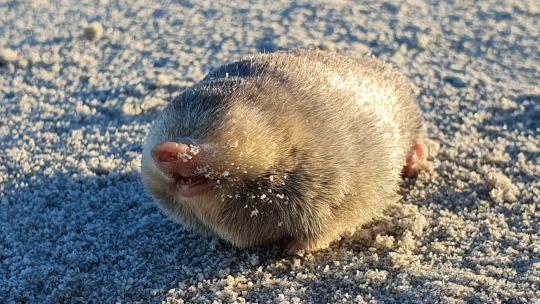
An elusive little mammal was spotted for the first time in nearly a century
Species Concerned: De Winton's Golden Mole (Cryptochloris wintoni)
Family: Golden Mole Family (Chrysochloridae)
Source(s): here and here
A small, superficially mole-like animal seemingly found only in the area around Port Nolloth, South Africa, De Winton’s Golden Mole has long been feared to be extinct due to a total lack of confirmed sightings since 1937. This changed in November of 2023, when (after years of extensive searching) a De Winton’s Golden Mole was found alive for the first time in 87 years, and was photographed for the first time ever.
Though similar to moles in both appearance and behaviour, golden moles are actually part of a separate and only distantly related group of mammals known as Afrosoricidans (alongside tenrecs and otter shrews) that have independently developed mole-like bodies to exploit a similar ecological niche – with massive, shovel-like front paws, short limbs, protective “shields” of toughened skin on their heads and non-functional eyes covered by skin to protect them from irritation, members of this family are adapted to burrowing, and in most cases will spend their entire lives underground unless disturbed. Due to the scarcity of sightings very little is known about the biology of De Winton’s Golden Mole, but based on its sandy coastal habitat and the behaviours of its closest relative, the Van Zyl’s Golden Mole (Cryptochloris zyli) it is likely that members of this species live solitary lives and use their digging abilities to “swim” through sand, preying on insects and small vertebrates which they detect using unique structures in their inner ears that are highly sensitive to vibration.
In addition to conventional habitat surveys within De Winton’s Golden Mole’s presumed range, the team responsible for this species’ rediscovery also utilized several newer or more unusual strategies to search for their focal missing mammal, including thermal imaging to detect underground body heat and the testing of soil and sand in the area for eDNA (tiny amounts of genetic material that organisms leave in water, soil and on other surfaces, giving insight into which species are found in an area without having to actually spot them.)
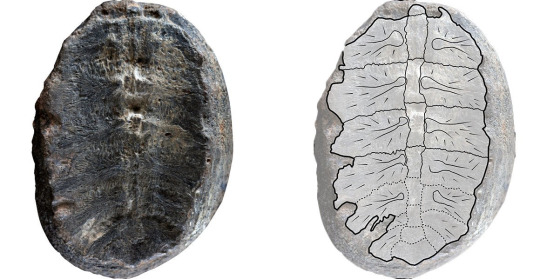
An "ancient plant" turned out to be a baby turtle
Species Concerned: "Turtwig" Cretaceous Turtle
Family: Unknown
Source(s): Here and Here
In 2003, a priest and fossil collector named Gustavo Huertas identified what he believed to be the fossilised remains of a tiny plant of the extinct genus Sphenophyllum in cretaceous-era rocks near Villa de Leyva, Columbia, and named the new species Sphenophyllum colombianum. Huertas' find was unusual in that it dated to the early Cretaceous period (making it over 100 million years younger than other Sphenophyllum species, the last of which are believed to have gone extinct in the late Triassic period,) and it was the fossil's unusual age that drew the attention of Fabiany Herrera, a curator of plant fossils at the Field Museum of Natural History in Chicago, USA and Héctor Palma-Castro, his student. After taking an interest in the fossil the two travelled to the Universidad Nacional de Colombia in Bogotá, Columbia where the fossil was held in order to inspect it, and after realising that its features were unlike other Sphenophyllum species and consulting a vertebrate palaeontologist, Edwin-Alberto Cadena, they eventually came to realise that what Huertas had found was not a Sphenophyllum species, or event a plant - what had originally been interpreted as the stems and leaves of a plant were actually the ribs of a very small, and likely very young, prehistoric turtle.
The ribs of turtles are located on the upper surface of their shells, where they form a sort of "roof" that strengthens the shell's outer carapace. Newly hatched turtles have fragile bones and shells that are easily broken beyond recognition during fossilization, so finding the well-preserved remains of a young turtle (estimated to be less than 1 year old when its bones were buried) is very rare. The discovery of the true identity of "Sphenophyllum colombianum" was published (here) in early December 2023, and as such the newly discovered turtle fossil has yet to be given a new name. Instead, it has been affectionately dubbed "Turtwig", after the half-plant-half-turtle gen 4 starter Pokemon, until it can be formally reclassified.
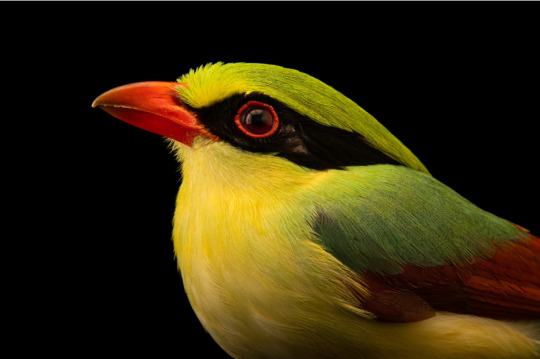
The Indochinese Green Magpie became the Photo Ark's 14,000th species
Species Concerned: Indochinese Green Magpie (Cissa hypoleuca)
Family: Crow Family (Corvidae)
Source: Here
The National Geographic Photo Ark is an ambitious project led by Canadian photographer Joel Sartore which aims to photograph every species held in captivity worldwide, providing high-quality images of often relatively obscure species and raising awareness of each species involved. In 2021 the Arabian Cobra became the 12,000th species added to the ark, in 2022 the Spoon-Billed Sandpiper became the 13,000th, and as of May 2023 the Indochinese Green Magpie has become the 14,000th species Sartore and his team have photographed.
Unlike the vast majority of crow species, the 4 species in the genus Cissa, known collectively as green magpies, are brightly coloured, largely carnivorous birds with vivid green feathers and bright red beaks and feet which are thought to aid them in camouflaging against the leaves and bark of the dense, humid forests they typically inhabit. The Indochinese Green Magpie, which is found in densely forested areas from central China to southern Cambodia, is one of the most common green magpie species, but is still believed to be experiencing a decline in population size due to the intense demand for members of this species in the illegal wildlife trade, both for their feathers and to be kept as illegal pets. The model for Sartore's photo, a female named Jolie, was herself found in a suitcase that was intercepted while being smuggled through the Los Angeles International Airport, and is now kept Los Angeles Zoo and Botanical Gardens. The team behind the Photo Ark have expressed hopes that Jolie's picture and story will help to raise awareness of the harmful effects of the illegal exotic pet trade and its prominence within the USA. On a happier note, the photo also seems to show that Jolie is now doing well - green magpies kept in captivity have been known to sometimes take on a duller colouration due to a lack of carotenoids in their diet, so her natural green feathers are an indicator of good health.

A very rare, very weird plant was rediscovered after 30 years
Species Concerned: Thismia kobensis
Family: Burmannia Family (Burmanniaceae)
Source(s): Here, here and here
In 1992, a bizarre-looking plant was found growing near the city of Kobe in Japan; pale and partially transparent without any leaves or chlorophyll, it was a member of the genus Thismia and was notable for being found further north than any other Asian species in the genus to date. A single plant was collected and taken to the Museum of Nature and Human Activities in the nearby city of Sanda, and in 2018 extensive examination of this single preserved plant led to it being determined to be a previously undocumented species, Thismia kobensis. This discovery led to surveys being dispatched to the area where the species was originally discovered in hopes of gathering additional samples and learning more about T. kobensis in the wild, but after surveys of the area were unable to find any remaining individuals, and following the discovery that the site from which the original sample had been collected had been converted into an industrial complex since the 1990s, the species was feared to have gone extinct. In February of 2023, a team of researchers led by Kobe University's Professor Kenji Suetsugu announced the first documented sighting of Thismia kobensis in 31 years, having found a small population growing in Sanda, not far from the museum that holds what had long been the only known specimen of the species and roughly 30km (18.6 miles) from the site at which the species was originally discovered. Their publication can be read here.
Thismia species, also known as fairy lanterns, are almost alien-looking plants that, as mentioned previously, lack chlorophyll and do not carry out photosynthesis, instead gaining nutrients parasitically by connecting their roots to the hyphae of typically mutualistic fungi and extracting nutrients from both the fungus itself and from any other plants that it has connected to (making it a mycoheteroph, much like the slightly better-known ghost plant/ghost pipes.) This unusual lifestyle likely developed as an adaptation to allow members of this genus to survive in forests with dense canopies that block out sunlight, but also makes them highly sensitive to environmental change - in order for an area to support a healthy population of Thismia kobensis, it must also support healthy trees and healthy soil fungi. As the original preserved 1992 specimen of T. kobensis was long dead and slightly damaged, its rediscovery also allowed Suetsugu's team to further study the species, leading to a surprising conclusion - genetically and anatomically, Thismia kobensis seems to have more in common with Thismia americana (the only known North American species of Thismia, which was last sighted in 1916 and is similarly feared extinct) than to any other Asian Thismia, possibly suggesting that T. kobensis and T. americana are descended from common ancestors that spread either from Asia to the Americas or vice versa during a time when their ranges were connected by a land bridge.
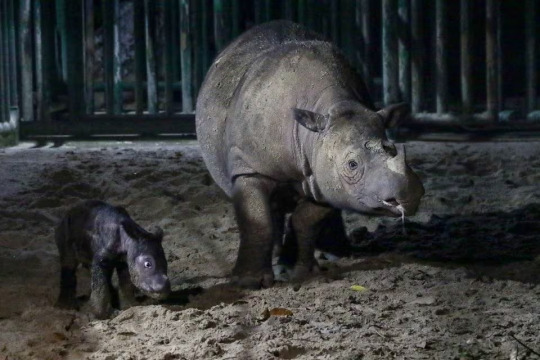
Important progress was made in saving the Sumatran Rhinoceros
Species Concerned: Sumatran Rhinoceros (Dicerorhinus sumatrensis)
Family: Rhinoceros Family (Rhinocerotidae)
Sources: Here and here
Distinguished from the other 4 rhinoceros species by its relatively small size, 2 horns and short black fur (which is barely present in adults, but very prominent in calves) the Sumatran Rhinoceros is one of the rarest mammals on earth, with an estimated population size of roughly 30-80 individuals. Having had its numbers drastically reduced by poaching, habitat loss and extreme weather events, the species is now threatened by its own small population size - found only in tiny scattered populations across Sumatra and Borneo, it is now extremely difficult for wild members of this species to find mates, and where mating does occur such a small population size considerably limits genetic diversity, increasing the risk of calves being born with health complications. To combat this numerous efforts to breed Sumatran Rhinoceroses in captivity have been developed, and as of November of 2023 the results have been promising; last year saw the birth of 2 Sumatran Rhinoceros calves at the Way Kambas National Park in Lampung, Sumatra.
The youngest of 2023's calves, a male, is the son of a female named Delilah who was herself the second calf to have ever been born at the park's Sumatran Rhinoceros Sanctuary (a site where members of this species are cared for and protected from illegal poaching while breeding.) This marks the first-ever instance of a captive-born Sumatran Rhinoceros giving birth, and therefore represents a key step in establishing a healthy captive breeding population of Sumatran Rhinoceroses to help preserve and increase the genetic diversity of wild populations. The calf's father, named Harapan, was born in Cincinnati Zoo in the USA, and it is hoped that the careful incorporation of the handful of Sumatran Rhinoceroses held in zoos into wild breeding programs can further help to increase the species' genetic diversity in the future. While extensive action is still needed for the Sumatran Rhinoceros to be saved, the park's work this year represents a significant step towards the species' conservation.
--------------------------------------------
Have a great new year!
#Happy new year!#2023#2024#zoology#biology#mammalogy#paleontology#botany#ornithology#conservation#animal#animals#plant#plants#wildlife#turtwig#de winton's golden mole#golden mole#golden moles#Indochinese green magpie#green magpie#green magpies#Thismia kobensis#Thismia#Sumatran rhinoceros#rhinoceros#rhinoceroses
39 notes
·
View notes
Text
this whole matter of trying to sell things is so boring and distasteful. can you put some very bad (or very good) pattern ideas/requests in my ask to take my mind off it? please and thank you. anon is on.
I do want to start kicking these collections out the door on a two-week schedule (/shill) so the more nonsense ideas milling around of my brain the better, for once. Some off the top of my head:
Dressing Table – High Femme/Old Queen/Pickled Egg boudoir kitsch. Perfume bottles and roses in bell jars and Persian cat figurines and Art Nouveau vanity sets etc.
Viscera – Offal, just offal.
Diatoms, Animalcules, etc. These would especially be fun if I can figure out how to design round motifs (I've done one and it was just okay-looking and very hard) to mimic a microscope view.
Pollen grains – In a similar vein, my mother was a palynologist and I'd love to do a set of black-background motifs in the style of scanning electron micrographs.
Philately – I was a terrible stamp collector as a child (catastrophically disorganized from the word go), but I have a "postage stamp" border treatment I've been wanting to use.
Cryptids & Company – Mostly I just liked the title, "Putative Extinctions and 'Living Fossils'" is probably more the thing. Cryptids-as-such being culture-bound, I'd either want to limit myself to white-people cryptids (so like the loch ness monster and whom else? mothman?), which is it's own kind of weird, or solicit design/editorial assistance from someone qualified.
Turtle Island Food Science – American Thanksgiving is my problematic favourite holiday, and maybe that specific title is too dippy-white-Liberal to fly, but I do want to do a collection of Indigenous North American cultivated plants at some point.
Rune Stones – I was a teenage, twenty-something neopagan twenty years ago, it's true, but I still think this would be cute.
Things people actually buy at vendor markets – and it's just like, a knockoff Stanley mug, American junk food smuggled up from North Dakota, MLM leggings, essential oil jewellery and pickles
2 notes
·
View notes
Text

A stock photo shows a Dinosaur Fossil simulator excavation used for education. Researchers recently discovered the Fossil of a new Aetosaur Species in Texas. IStock/Getty Images
Extinct 'Eagle Lizard' Found in Texas Canyon
— Newsweek | January 19, 2023
Researchers recently learned that a fossil unearthed in 1989 was actually a new reptile species that lived roughly 218 million years ago in what is now a Texas canyon.
The newly identified species, Garzapelta Muelleri, is a type of Aetosaur, which means "Eagle Lizard" because the reptile's skull resembles that of a bird, according to a report by Sci.News. Like alligators, aetosaurs roamed wet regions across the supercontinent Pangea during the Late Triassic Period, the University of California Museum of Paleontology says.
The museum says the aetosaurs were heavily armored with a crocodile's body, pig's snout and bird's skull. The newly discovered reptile was up to 11.5 feet long, according to a study about the newly identified species that was published in The Anatomical Record on January 11.
Aetosaurs were believed to be omnivores and herbivores. They vanished at the end of the Triassic period because of a mass extinction event.
The aetosaur's fossilized skeleton was first found by Paleontologist Bill Mueller from Texas Tech University and local amateur collector Emmett Shedd in 1989 in the Cooper Canyon Formation in Garza County, Texas. But Mueller died in 2019, and many of his projects remained unfinished. William Reyes, a paleontologist and Ph.D. candidate at the University of Texas at Austin, was invited to lead the description of the new species that was published earlier this month in The Anatomical Record.
The skeleton was found along with the creature's carapace, a hard outer shell that is similar to that of a turtle. The study said that the carapace fossil provides "new insight" into carapace variation across the species and that the findings imply that researchers were "dealing with the emergence of a new group of aetosaur."
"Everyone agreed that it was indeed a new species, as it exhibited several unique features in its armor that differentiate it from any other known Aetosaur Species," Reyes told Newsweek. "However, where exactly it fell in the evolutionary tree of this group remained contentious."
Reyes said the next steps in his research include reassessing some of the aetosaur relatives of the Garzapelta Species.
Researchers believe that aetosaurs lived across the world, as their fossils have been found in Europe and North and South America, the University of California museum said. The most common aetosaur fossils that researchers find are the hard plates that make up the body armor, the report said.
The discovery comes after researchers found two new species of an "Iconic and Bizarre" dinosaur group in North America at the end of last year.
Earlier this month, a fossil found by a pair of hikers last year was identified as the skull of a huge new species of prehistoric fish that lived around 72 million years ago.
Researchers also announced the discovery of the remains of a large flying reptile that roamed Earth's skies 100 million years ago during the age of the dinosaurs.
In other locations across the world, scientists are finding that species they thought were extinct are still thriving in the wild, like the De Winton's golden mole in South Africa 🇿🇦 and the Attenborough's long-beaked Echidna in New Guinea 🇬🇳.
"I think it's just fantastic that...we can still rediscover species," said Cobus Theron, a member of the research team that found the golden mole, in a press release. "All of our stories around conservation are doom and gloom. Here we have an opportunity to say that, actually, there are opportunities to make change."
#Newsweek#Dinosaur Fossil#Extinct 'Eagle Lizard'#Fossil#Aetosaur Species#Texas | USA 🇺🇸#Texas Canyon#University of California Museum of Paleontology#Paleontologist | Bill Mueller | Texas Tech University#Garzapelta species#William Reyes | Paleontologist#University of Texas at Austin
0 notes
Text
The gang plays Animal Crossing: NH
I haven’t played since Christmas because my joycons had ~ issues ~ but now I’ll be able to return to it pretty soon so here ya go ^^ (also took a while to make this as I dont know the English names of the villagers so I had to look it up lol)
________________________________________
Leonardo
Calls his island: Oshika
Organized
He makes a Japanese themed village and puts trees around all of the paths
There are flowers everywhere and he has a garden where he breeds every type of flowers because he wants all the colors
Only has cherry trees and bamboos
Never time travels (he thinks it’s cheating)
He doesn’t really cares about his character’s clothes because he pull all of his focus into his island, but still buys all the kimonos and other eastern dresses and robes
Waterfalls everywhere
He also puts lanterns everywhere (especially the small ones, he thinks they’re cute)
He loves the Japanese themed items and his island reflects this
His house has a really simple decoration, it’s more minimalist than the rest of his island
His favorite villagers are Bea and Kabuki
He will get rid of a villager if he doesn’t like their house tho
On his island he has: Bea, Chester, Chow, Croque, Drago, Genji, Kabuki, Margie, Pekoe, Snake (all choosent because he likes their house style and it goes well with his theme, except Bea, he just loves her)
Donatello
Calls his island: Cretaceous
A collector
He mostly tries to get every fruit, bugs, fish, art pieces, DIY recipes, etc
Doesn’t really like breeding flowers but still wants them all, so he visits Leo’s island and steal his hard work (only one of each tho)
Time travels a lot because he doesn’t have the patience to wait months to get his bugs and fish
Goes insane whenever he completes a new fossil and tries to keep one set off every fossil for himself
He decorates his island with his favorites and tries to do a Jurassic Park theme
He hides them in forests, or he puts them in front of waterfalls and puts light spots under them to make them more menacing
There are almost no paths and they’re just dirt, trees everywhere and a few lanterns here and there
Also he puts the fake statues he got from Redd next to the shops to give an ~*°ambiance°*~
Has a library sort of space next to his museum
His character has a few outfits: Black Ninja outfit, Pirate captain outfit, hawaian shirt and floral shorts for when he visits someone’s island
His favorite outfit is: tortoise specs, avocado Explorer’s outfit, brown Traveler’s backpack
His favorite villagers are Mitzi and Lucky
On his island he has: Agnes, Avery, Beau, Lucky, Mitzi, Ozzie, Sparrow, Stella, Tad, Wolfgang (he loves ‘natural’ villagers, his two favorite being the exceptions)
Raphael
Calls his island: New York
He’s terrible at naming and couldn’t care less about it
He make a very urban island
Surprisingly organized, with residential area, shopping area, etc
He has a few trees and flowers, but mostly puts them near the villagers houses and does little gardens for them
He also makes a park with trees and flowers, a few benches etc
He can't catch bugs and keeps getting stinged by wasps lmao
Relies either on Donnie or on Nookazon to get the stuff he wants
His island anthem is bonkers
Doesn't really follow a specific theme other than it reminds him of a city
Barely upgrade his house (he can't decorate it so why loosing all his bells?)
Also doesn't really have an outfit other than he always has sunglasses on
His favorite villagers are Apollo and Cherry
On his island he has: Apollo, Boomer, Cherry, Cousteau, Eugene, Gladys, Hopper, Naomi, Raymond, Winnie,
Michelangelo
Calls his island: Lollipop
His island is super colorful
It’s an organized mess
The paths are clear and you can find them easily, but the decorations are all over the place
He loves making furniture of every color
Gifts his villager flower crowns so they’d hang them on their doors
Also gets his flowers from Leo
Likes candy / mermaid furniture
Has a Rickroll hidden somewhere and he changes it’s place every two weeks so his brothers get a surprise from time to time
His house has a different theme per room
So again, a mess, but each room is carefully thought through
Makes a lot of his own patterns, both for the paths but for his clothes too
Also customize his island anthem (it's either a really cool tune he made or a meme)
He likes the most colorful villagers
His favorite villagers are Filibert and Merengue
On his island he has: Bob, Caroline, Cookie, Drift, Filibert, Merengue, Loly, Tia, Renée, Wendy
April
She calls her island: Northampton
Really organized too
There's a Café, a big veggie garden with a farm, the campsite has a bonfire and all
She likes putting stairs everywhere so there are a lot of cliffs
Also has a residential area, but she puts the shops right next to the Residence Service Building and makes a huge plaza with a fountain and all
She has 4 loose snapping turtles on her island that she loves and cherishes
There are different kind of gardens all over her island
Theres also a picnic area
Decorates her pier and makes it a fish market
Also the rocky side is Pirate themed
There are mushrooms everywhere in her forests, and her flowers are mostly white, red, pink, black and purple
Her favorite villagers are Cranston and Frobert
On her island she has: Cranston, Etoile, Frobert, Goldie, Hopkins, Lopez, Portia, Prince, Rex, Willow,
Casey
He calls his island: Paradise
There's more water than land with all the waterfalls and rivers he puts everywhere
He turns it into a beach / summer heaven
Bridges everwhere
It's very light and colorful, and what he doesn't organize he makes it up in decorations and banners
Asked Mikey to make him some custom designs
He made a little restaurant by the sea and a dock area
Palm trees everywhere
Like he has other trees for the Miles Nook quests but that's it
Also likes to gift his villagers beach clothes so they would wear it and keep the theme going
Has a lot of aquariums in his house as well as a few mermaid furniture
His favorite villagers are Audie and Whitney
On his island he has: Audie, Bud, Canberra, Chai, Diana, Flora, Melba, Piper, Reneigh, Whitney
#tmnt#bayverse tmnt#tmnt leonardo#tmnt raphael#tmnt donatello#tmnt michelangelo#tmnt april#tmnt casey jones#tmnt headcanons
62 notes
·
View notes
Text
Vancleavea campi

By Tas Dixon
Etymology: Named after Phillip Van Cleave
First Described By: Long & Murry, 1995
Classification: Biota, Archaea, Proteoarchaeota, Asgardarchaeota, Eukaryota, Neokaryota, Scotokaryota, Opimoda, Podiata, Amorphea, Obazoa, Opisthokonta, Holozoa, Filozoa, Choanozoa, Animalia, Eumetazoa, Parahoxozoa, Bilateria, Nephrozoa, Deuterostomia, Chordata, Olfactores, Vertebrata, Craniata, Gnathostomata, Eugnathostomata, Osteichthyes, Sarcopterygii, Rhipidistia, Tetrapodomorpha, Eotetrapodiformes, Elpistostegalia, Stegocephalia, Tetrapoda, Reptiliomorpha, Amniota, Sauropsida, Eureptilia, Romeriida, Diapsida, Neodiapsida, Sauria, Archosauromorpha, Crocopoda, Archosauriformes, Eucrocopoda, Proterochampsia?, Doswelliidae?
Status: Extinct
Time and Place: 228 to 203.6 million years ago, in the Norian of the Late Triassic

Vancleavea is best known from the Petrified Forest in Arizona and Ghost Ranch in New Mexico, but is found throughout the Chinle Formation in Arizona, New Mexico, Texas and Utah in the southern United States. It is also known from the Tecovas Formation in Texas, and the Redonda and Bull Canyon Formations in New Mexico.

Physical Description: Vancleavea is a peculiar reptile, even by Triassic archosauromorph standards. It effectively resembles an armoured, scaly eel with tiny legs, a long neck, the tail of a crocodile and a frighteningly fang-toothed skull. The largest complete specimen is approximately 1.2 metres (3.9 feet) long, although isolated pieces from other specimens indicate it could grow larger. Most of its body is covered in an array of overlapping bony osteoderms that come in 5 different shapes on the main body, throat, underbelly, limbs and tail (as well as possibly some strange spike-like osteoderms of unknown position). Uniquely, the osteoderms on the tail are tall and flat from side to side, forming a tall fin along the top of the tail for swimming. No other tetrapod—except for the closely related Litorosuchus—has a tail fin like this (usually they are made of tall neural spines from the tail bones).
Vancleavea’s skull is also unusual, as it is very robust and solid, despite the relatively thin and pointed snout. The back of the skull is boxy and has completely closed over the upper temporal fenestra, leaving just the very large lower temporal fenestra. The antorbital fenestra in front of the eyes, a typical feature of archosauriform reptiles, has also been lost, and the snout is short with nostrils that point directly upwards. The jaw bones of Vancleavea are heavily pitted and have a rough texture, which combined with the large teeth imply Vancleavea lacked lips and had exposed fangs, similar to crocodiles. Vancleavea had three fangs on each side of its jaws, one at the front, one on the lower jaw, and another on the upper jaw behind the bottom fang. The dentary fang slotted into a gap in the upper jaw when the mouth was closed, again similar to crocodiles.
The body of Vancleavea is long and tubular, enhanced by both the unusually long neck and the small size of its limbs. It’s unlikely Vancleavea’s limbs were strong enough to lift its body off the ground on land, and in fact the forelimb is so reduced that the shape of some its finger bones suggests it had even lost the claws on its hands. All in all Vancleavea is very clearly built to be semi-, if not almost entirely, aquatic, swimming with a sinuous, eel-like motion and rarely crawling onto land, perhaps only to lay its eggs.
Diet: The massive, serrated fangs and conical teeth indicate Vancleavea was carnivorous, likely feeding on fish and other aquatic prey, such as small temnospondyl amphibians.
Behavior: Vancleavea is almost certainly semi-aquatic, using its deep, finned tail to scull through the water similar to living crocodilians. It’s speculated that Vancleavea lived as an ambush predator, lunging forward to snag prey in its fangs. It lived in slow-moving freshwater environments, and its elongated, sinuous body would have been perfect for winding through plants and logs and other obstacles in the water.
Ecosystem: Vancleavea is known from much of the Chinle Formation, one of the most well known Late Triassic formations in the world, and its longevity means that it coexisted with a wide variety of other animals. There were of course the dinosaurs, including the likes of Coelophysis, Chindesaurus and Daemonosaurus, along with other dinosauriforms such as silesaurids and the lagerpetid Dromomeron, as well as early pterosaurs. Pseudosuchian archosaurs were incredibly abundant, such as the numerous herbivorous aetosaurs and Revueltosaurus, the dinosaur-like poposauroids including the herbivorous beaked Shuvosaurus and Effigia, as well as the predatory Poposaurus. Rauisuchid pseudosuchians were among the top predators, such as Postosuchus, while small long-legged crocodylomorphs like Hesperosuchus and Parrishia chased after smaller prey. Various other archosauromorphs were present too, including the bizarre drepanosaurs, herbivorous allokotosaurs such as Trilophosaurus and an unnamed azendohsaurid, and the strange armoured Doswellia, possibly Vancleavea’s closest relative. There was even an early turtle, Chinlechelys, one of the earliest known to have a fully formed shell, and a relative of the tuatara, Whitakersaurus. The only definitively known synapsid from the Chinle is the large herbivorous dicynodont Placerias.
In the water, Vancleavea would have coexisted with numerous species of giant phytosaurs—crocodile-like reptiles that may-or-may-not be pseudosuchians—such as Leptosuchus and Machaeoprosopus, as well as the predatory temnospondyl amphibian Anaschisma (formerly known as Koskinonodon). Vancleavea’s heavy armour may have been necessary protection against these predators, which could have had jaws almost as long as it was! Fish were abundant in the freshwater ecosystem, with various ray-finned fish such as the pike-like Saurichthys, the large lungfish Arganodus, freshwater sharks such as Xenacanthus, and even a freshwater coelacanth, Chinlea. Many of these fish grew to as large or larger than Vancleavea, and may have competed with it or even preyed upon it (at least as juveniles).
Vancleavea also coexisted with several other, more mysterious reptiles that are mostly only known from teeth. One of these, Acallosuchus, was discovered close by to the original specimen of Vancleavea. The skull and skeleton were originally suggested to belong to the same animal, but we now know Vancleavea had a very different skull to Acallosuchus. Supposedly its skull was long, pointed and triangular, with a knobbly texture on the bones. I say “supposedly” because the skull disintegrated while it was excavated, and all that’s left is a crude drawing and a few pieces of bone. The identity of Acallosuchus remains a mystery. Other mysterious species that Vancleavea coexisted with are the former ornithischians Tecovasaurus and Crosbysaurus, Colognathus, Palacrodon, the possibly venomous Uatchitodon, and the extremely enigmatic Kraterokheirodon known only from two teeth so unlike any known tetrapod alive or extinct it can only be classified as Amniota incertae sedis! Vancleavea was once in the same boat as all these creatures, known only by pieces of the skeleton and its armour, and with any luck, Acallosuchus and the other mystery creatures will end up like Vancleavea and turn up some complete skeletons one day.
Other: Vancleavea is known from throughout the Chinle Formation and several other localities in the southern US, however, most of these specimens consist of isolated bones and osteoderms. The Chinle Formation covers many tens of millions of years from top to bottom, and it’s unlikely the single species V. campi was that long-lived (its range spans a whole 20 million years!). Variations between some specimens suggest that there may be more diversity within Vancleavea then we currently recognise. However, until better specimens are found and can be compared, we can’t be sure how Vancleavea evolved and changed throughout the course of the Chinle.
Vancleavea has a fairly complicated history, the holotype was first discovered in the Petrified Forest by fossil collector Phillip Van Cleave, who lent it his name, but it wasn’t described and named until 1995 and still only consisted of a fragmentary skeleton. Nearly complete specimens from Ghost Ranch were discovered in 1982, but they wouldn’t be recognised as Vancleavea until decades later. In 2008, new specimens from the Petrified Forest were published, but Vancleavea still had to wait another year before the Ghost Ranch specimens were extensively described and its strangeness could be fully appreciated.
Until recently, Vancleavea was the only known stem-archosaur of its kind known in the world, and its relationship to other archosauriforms was enigmatic. However, the discovery of the closely related Litorosuchus from China indicates that the Vancleavea-family (“vancleaveans”) was indeed more diverse and widespread. Unlike Vancleavea, Litorosuchus was marine, and had a much longer, almost spinosaur-like snout. The position of Vancleavea in the archosauromorph tree is still uncertain, but it has been suggested to be a type of proterochampsian, a group of typically crocodile-like reptiles closely related to archosaurs proper. Particularly, it has been allied to the family Doswelliidae, a peculiar family of proterochampsians with similarly strange armour and skeletons. Regardless of where it truly belongs, Vancleavea is at least generally agreed to be a fairly derived archosauriform, quite close to the crown group of Archosauria, albeit having evolved down a very unusual, unique route all of its own.
~ By Scott Reid
Sources under the cut
Hunt, Adrian P.; Lucas, Spencer G.; Spielmann, Justin A. (January 2005). "The holotype specimen of Vancleavea campi from Petrified Forest National Park, Arizona, with notes on the taxonomy and distribution of the taxon". New Mexico Museum of Natural History and Science Bulletin. 29: 59–65.
Li, C.; Wu, X.-C.; Zhao, L.-J.; Nesbitt, S.J.; Stocker, M.R.; Wang, L.-T. (2016). "A new armored archosauriform (Diapsida: Archosauromorpha) from the marine Middle Triassic of China, with implications for the diverse life styles of archosauriforms prior to the diversification of Archosauria". The Science of Nature. 103 (95): 95.
Long, R. A. & Murry, P. A. (1995). "Late Triassic (Carnian and Norian) tetrapods from the southwestern United States". New Mexico Museum of Natural History and Science Bulletin. 4: 1–254.
Miller, Zachery (November 17 20016). D&D Monsters of the Triassic. Waxing Paleontologist.
Nesbitt, S. J.; Stocker, M. R.; Small, B. J.; & A. Downs (November 26, 2009). "The osteology and relationships of Vancleavea campi (Reptilia: Archosauriformes)". Zoological Journal of the Linnean Society. 157 (4): 814–864.
Parker, W. G.; Barton, B. (2008). "New information on the Upper Triassic archosauriform Vancleavea campi based on new material from the Chinle Formation of Arizona". Palaeontologia Electronica. 11 (3)
#vancleavea#archosauromorph#diapsid#reptile#triassic#triassic madness#triassic march madness#prehistoric life#paleontology
287 notes
·
View notes
Note
Have you ever gotten the feeling that an animal only wants a specific part of them preserved? Like, “you can take this part but nothing else”
I’ve never had that feeling for a specific part but I definitely know what you are talking about and I have totally felt it with animals I’ve encountered over the years. I’ve told their stories here many times over the years so I’ll keep the retellings brief to not bore you guys.
There was the aborted opossum fetus I found at my back door one morning quite a few years ago. It had been dropped by it’s fatally wounded mother who I saw later that morning hobbling around in the pasture, missing a leg. She’d probably been attacked by a dog or coyote. I ran in to grab my gun so I could put her out of her misery but she was gone by the time I got back outside. My dog found her skeleton a few months later. I kept the skeleton but the fetus was very sad and strange and keeping it felt wrong so I buried it.
Some local jerk poached a huge buck a few years ago and then dumped it in my road. It was a massive animal but they didn’t take any of the meat—just cut the head off and left it. I called it in to local fish & game and an officer came out to make a report. After we moved it out of the road and he left I went back and drug the buck further out into the woods so he could hopefully find some peace. Poor guy had some seriously negative vibes around him but when I went back a few months later just to see the bones everything felt a lot better. Didn’t take anything from him.
Last summer I was hiking around the swamp at the back of my property and I found a whole snapping turtle skeleton. I started to collect it but instantly felt like he was right where he wanted to be—at home in his swamp—so I left him alone. Found a cat skeleton a few yards away that I did collect. None of those “leave-me-be” vibes with it.
There was also the time when I was hiking around a creek on a relative’s property out in the middle of nowhere. I was a young teenager but was already an avid bone cleaner and collector so I wasn’t squeamish and was always excited to come across something new to add to my collection. As I was strolling along, picking up rocks and fossils, my gaze locked with a pair of eyes looking up at me from the gravel bar. It was a decapitated cat head. Fresh, hardly any flies even after it yet. But as I looked around I couldn’t see any sign of the rest of it or even any blood around. That was the first time I encountered such a negative feeling around a creature’s remains. I backtracked quickly and left it alone.
There have been a few others but those encounters have always stood out the strongest. There was never any denying the feeling that they all wanted to be left to nature.
So yeah, I think maybe energy sticks around sometimes. Maybe it’s not ready to let go, maybe it’s just happy where it is. Maybe it’s something else entirely. I dunno, but I always feel like it is important to trust your gut and listen to what those vibes are telling you. If you feel like only a certain part of an animal should be preserved then I’d honor that wish. It seems like the respectful thing to do.
135 notes
·
View notes
Photo

On Nov. 19, 2019, England’s Summers Place Auctions, the world’s leading auctioneer of Natural History, is having an Evolution Auction.

All sorts of things will be up for grabs, like this mounted Leatherback Turtle head estimated to sell between £100-£200. He needs a hat.

Two boxes of human bones estimated between £300-£500.

There’re all sorts of things like fossils, skulls, taxidermy, and a few dinosaur skeletons like this Sabre Toothed Cat, £12,000 - £18,000.

This is nice. £2000-£3000


But the star of the show is the DoDo skeleton. It was collected piece by piece at different auctions, by a collector who pieced it together to make as complete a skeleton as possible. He’s decided to sell it, there’s only one complete one in the world, and there will never be another, so this is expected to go for over $620,000. Auctions are only fun if you can bid on stuff.
https://www.summersplaceauctions.com/
24 notes
·
View notes
Photo

Is a genus of theropod dinosaur which lived in the Barremian stage of the Early Cretaceous period, about 130–125 million years ago. The first skeleton was discovered in 1983 in the Weald Clay Formation of Surrey, England, and became the holotype specimen of Baryonyx walkeri, named by palaeontologists Alan J. Charig and Angela C. Milner in 1986. The generic name, Baryonyx, means "heavy claw" and alludes to the animal's very large claw on the first finger; the specific name, walkeri, refers to its discoverer, amateur fossil collector William J. Walker. The holotype specimen is one of the most complete theropod skeletons from the UK (and remains the most complete spinosaurid), and its discovery attracted media attention. Specimens later discovered in other parts of the United Kingdom and Iberia have also been assigned to the genus. The holotype specimen, which may not have been fully grown, was estimated to have been between 7.5 and 10 metres (25 and 33 feet) long and to have weighed between 1.2 and 1.7 metric tons (1.3 and 1.9 short tons; 1.2 and 1.7 long tons). Baryonyx had a long, low, and narrow snout, which has been compared to that of a gharial. The tip of the snout expanded to the sides in the shape of a rosette. Behind this, the upper jaw had a notch which fitted into the lower jaw (which curved upwards in the same area). It had a triangular crest on the top of its nasal bones. Baryonyx had a large number of finely serrated, conical teeth, with the largest teeth in front. The neck formed an S-shape, and the neural spines of its dorsal vertebrae increased in height from front to back. One elongated neural spine indicates it may have had a hump or ridge along the centre of its back. It had robust forelimbs, with the eponymous first-finger claw measuring about 31 centimetres (12 inches) long. Now recognised as a member of the family Spinosauridae, Baryonyx's affinities were obscure when it was discovered. Some researchers have suggested that Suchosaurus cultridens is a senior synonym (being an older name), and that Suchomimus tenerensis belongs in the same genus; subsequent authors have kept them separate. Baryonyx was the first theropod dinosaur demonstrated to have been piscivorous (fish-eating), as evidenced by fish scales in the stomach region of the holotype specimen. It may also have been an active predator of larger prey and a scavenger, since it also contained bones of a juvenile iguanodontid. The creature would have caught and processed its prey primarily with its forelimbs and large claws. Baryonyx may have had semiaquatic habits, and coexisted with other theropod, ornithopod, and sauropod dinosaurs, as well as pterosaurs, crocodiles, turtles and fishes, in a fluvial environment. Carnivore Baryonyx (c) Jurassic World Art (c) reneg661
1 note
·
View note
Photo

Trionyx Fossil Turtle Shell – Eocene Barton Beds Hampshire UK, Genuine Softshell Turtle Fossil
An exceptional and rare Trionyx fossil turtle shell discovered in the Barton Formation (Barton Beds), dating to the Eocene Epoch (~40 million years ago). This impressive specimen was collected by our dedicated fossil team members Alister and Alison on 08 June 2024 from Barton-on-Sea, Hampshire, and has been professionally cleaned, prepped, and treated by Alison.
Trionyx is a genus of extinct softshell turtles within the family Trionychidae, known for their leathery shells and aquatic adaptations. Their fossils are rarely found complete, making this partial shell specimen a significant and highly desirable piece.
Fossil Type: Turtle Shell (Reptile – Trionychidae)
Genus: Trionyx
Geological Age: Eocene – Bartonian Stage
Formation: Barton Formation (Barton Clay)
Depositional Environment: The Barton Beds were laid down in a shallow, subtropical marine to marginal marine environment with estuarine influence. These coastal systems were rich in life and conducive to the preservation of both marine and nearshore vertebrates.
Morphological Features:
Flattened carapace (shell) fragments typical of softshell turtles
Possible preserved margin or plastron elements
Mineralised bone texture visible under close inspection
Notable:
Rare Eocene turtle fossil from a classic British fossil site
Discovered and prepared by our own team with full provenance
Ideal for collectors, display, or educational use
The exact specimen shown is the one you will receive
Authenticity: All of our fossils are 100% genuine natural specimens and come with a Certificate of Authenticity. The scale cube in the image equals 1cm – please refer to the photo for full sizing.
This Trionyx fossil turtle shell from the Eocene of Barton-on-Sea offers a rare and scientifically valuable glimpse into the reptilian life of Britain’s ancient coastal environments. A standout piece for collectors and fossil enthusiasts.
#Trionyx fossil#fossil turtle shell#Barton-on-Sea fossil#Eocene turtle fossil#Barton Formation fossil#Hampshire fossil turtle#softshell turtle fossil#Trionychidae fossil#fossil reptile shell#UK Eocene fossil#genuine fossil turtle#collector turtle fossil#fossil reptile UK
0 notes
Text
Loss of Biodiversity and Extinction
Posted on March 29th, 2022 by Elodie Weinman
This week we will be discussing extinction and loss of biodiversity in Chapters 9 and 10 of Living in the Environment. Extinction is the “disappearance of all members of a species from the earth” and this happens when an animal “cannot adapt and successfully reproduce under new environmental conditions, or when a catastrophic environmental event wipes out its members” (Miller 176). Though extinction can occur unnaturally, it is a natural process that has “occurred at a low rate throughout most of the earth’s history” (Miller 176). Extinction can happen in a relatively short period of time and this is called a mass extinction. Mass extinctions are global and there are “geologic, fossil, and other records indicate that the earth has experienced five mass extinctions” (Miller 176). Mass extinctions can occur when there are extreme temperature changes, rising or falling sea levels, and one-off events like a huge volcano erupting or an asteroid hitting Earth. Extinction rates have increased over the years due to human population and growing ecological footprints, see Figure 1 for some examples of endangered animals that are borderline extinct. The annual extinction rate is “1,000 to 10,000 times the natural background extinction rate” (Miller 176). As well as extinct animals, some animals become endangered or threatened. An endangered species has “so few individual survivors that the species could soon become extinct”, while a “threatened species has enough remaining individuals to survive in the short term, but because of declining numbers, it is likely to become endangered in the near future”, see Figure 2 for some examples of endangered animals (Miller 178).
We need extinction, endangered, and threatened species rates to go significantly down because we need the species to successfully thrive on this planet. The world’s species “provide vital ecosystem services that help to keep us alive and support our economies” (Miller 180). They also “contribute to economic services that we depend on. Various plant species provide economic value as food crops, wood for fuel, lumber for construction, paper from trees, and substances for medicines. Bioprospectors search tropical forests and other ecosystems to find plants and animals” (Miller 180). The direct causes of species extinction, endangerment, and threat can be understood through the acronym HIPPCO. This stands for “Habitat destruction, degradation, and fragmentation; Invasive (nonnative) species; Population growth and increasing use of resources; Pollution; Climate change; and Overexploitation” (Miller 181). The greatest threat out of all of them is H, which is habitat destruction, degradation, and fragmentation. Habitat fragmentation is a process that occurs when a large area such as a forest or grassland is “divided into smaller, isolated patches or habitat islands…typically by roads, logging operations, crop fields, and urban development” (Miller 182).
Other reasons why species are going extinct is due to them being illegally killed (poached). Live animals are captured and sold to collectors for their valuable parts. The wildlife trade network estimates around $19 billion dollars a year (Miller 188). Some animals and their parts “can sell from tens of thousands of dollars to as much as $500,000 on the black market” (Miller 188). Often when the animals are illegally smuggled, the animals die while in transit. This makes the process even more cruel since they were wrongfully taken from their homes to be sold and they did not even make it off the boat or truck to be sold. Most smugglers are not caught or punished which is disturbing. Smugglers and buyers are also unaware that some “imported exotic animals carry diseases such as Hantavirus, Ebola virus, Asian bird flu, herpes B virus (carried by most adult macaques), and salmonella (from pets such as hamsters, turtles, and iguanas). These diseases can spread from pets to their owners and then to other people” (Miller 191). This could lead to a pandemic or epidemic that could potentially hurt millions of people. The United States created the Endangered Species Act (ESA) in 1973 and has amended it several times. This act is “designed to identify and protect endangered species in the United States and abroad. The ESA creates recovery programs for the species it lists. The goal is to help the populations of protected species recover to levels where legal protection is no longer needed” (Miller 194). Zoos, aquariums, game parks, and animal research facilities were also created so that some critically endangered animal species could be saved. At these facilities, researchers try ways to increase the population of captive species by “artificial insemination, insertion of semen into a female’s reproductive system, embryo transfer (the surgical implantation of eggs of one species into a surrogate mother of another species), and cross fostering (in which the young of a rare species are raised by parents of a similar species)” (Miller 197). The ultimate goal is for them to be preserved and then reintroduced into protected wild habitats.
One way to protect existing wildlands and species from human exploitation and human destruction is to designate them as “wilderness—areas essentially undisturbed by humans that are protected by federal law from harmful human activities”, see Figure 3 for an example of a wilderness area (Miller 219). Most resource extractors oppose this because wilderness areas often contain resources that provide economic benefits. In 1964, the “U.S. Congress passed the Wilderness Act, which allowed the government to protect undeveloped tracts of U.S. public land from development as part of the National Wilderness Preservation System” (Miller 219). There are more than 6,500 parks located in the world, 423 are located in the United States alone. Though these parks are a fantastic way to preserve wilderness and species, humans still have found ways to disturb the parks. In some U.S. parks and other public lands, “dirt bikes, dune buggies, jet skis, snowmobiles, and other off-road vehicles destroy or damage vegetation, disturb wildlife, and degrade the park experience for many visitors. Some visitors expect parks to have grocery stores, laundries, bars, and other such conveniences. Cell phone towers now degrade the pristine nature of some parks” (Miller 221). Parks are also threatened by nearby human activities such as “mining, logging, livestock grazing, coal-fired power plants, and urban development. The National Park Service reports that air pollution, mainly caused by coal-fired power plants and dense vehicle traffic, impairs scenic views more than 90% of the time in many U.S. national parks” (Miller 221). We must work to keep these national parks from being disturbed by human activities and destruction.
Word Count: 1067
Questions:
Why do you think humans tend to ruin things that are deemed good like national parks even though ruining them hurts themselves and others in the process?
Do you think that zoos and aquarium parks are morally ethical or are they also cruel and a form of punishment?
Figure 1: Mexican gray wolf, California condor, whooping crane, and Sumatran tiger are four examples of endangered animals that exist on this planet (Miller).
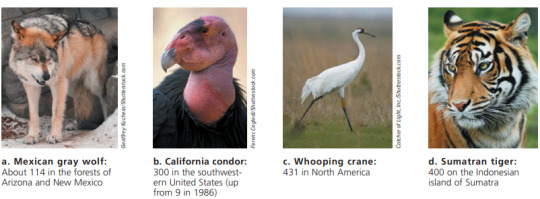
Figure 2: Eight examples of endangered animals and characteristics that deem them endangered (Miller).

Figure 3: This is Diablo Lake and it lies in a wilderness area in the North Cascades National Park in Washington (Miller).

Works Cited:
Beats, Geo. “Global Wildlife Population Declined by 50% in Last 40 Years - Video Dailymotion.” Dailymotion, Dailymotion, 30 Sept. 2014, https://www.dailymotion.com/video/x26ybub.
Kolbert, Elizabeth, and Jonathan Rosen. “The Sixth Extinction?” The New Yorker, 18 May 2009, https://www.newyorker.com/magazine/2009/05/25/the-sixth-extinction.
Miller, Tyler. “Chapter 9, 10.” Living in the Environment, Cengage Learning, Boston, MA, 2021.
0 notes
Text
Ancient Insect Genitals Found in 50-Million-Year-Old Fossil
https://sciencespies.com/nature/ancient-insect-genitals-found-in-50-million-year-old-fossil/
Ancient Insect Genitals Found in 50-Million-Year-Old Fossil
The fossil record is a lot more than just giant dinosaurs. In fact, some of the most impressive fossils are not hulking, pillar-like bones but the remains of small, delicate organisms that were buried in just the right conditions to reveal lost worlds to us millions of years after their deaths. A fossil bug recovered from the ancient strata of Colorado offers one such window into the past.
The fossil assassin bug, described today in Papers in Palaeontology, has perked paleontological attention because the rare specimen has its genitals intact. Chipped out of 50 million-year-old rock, the bug is so exquisitely-preserved that it almost looks ready to crawl out of the stone. Even the colored bands along the insect’s legs and body are visible. And just like exceptional circumstances were needed for the fossil to form, a lucky break was also needed to piece together this Eocene insect’s story.
The insect comes from a time when vast lakes covered swaths of what would become the western United States. Surrounded by warm, semitropical forests that hosted lemur relatives, early bats and other creatures, these lakes quickly buried organisms that settled to the mucky, oxygen-poor bottom and pressed many of them paper thin over 50 million years. Known as the Green River Formation, this rock unit has yielded some of the most exquisite and detailed fossils ever found.
Paleontologists aren’t the only people interested in Green River fossils. Privately owned quarries specialize in extracting, cleaning and selling fossils from the Green River Formation, especially rare species. That’s how half of the fossil assassin bug featured in the study came into the possession of private fossil collector and study co-author Yinan Wang. Word had it that the other half was owned by another private collector, Dan Judd, who donated the second piece to the researchers behind the new study.
The fossil assassin bug is named Aphelicophontes danjuddi in honor of Judd’s donation. What makes it truly special is that the genitals of this fossil bug can be seen in detail—a critical anatomical aspect that entomologists often use to distinguish assassin bugs from each other.
In technical terms, says University of Illinois at Urbana-Champaign entomologist and study co-author Daniel Swanson, the genital organ of the assassin bug is called a pygophore. “The word comes from two Ancient Greek roots that literally mean ‘rump’ and ‘something that carries,” Swanson says. The organ is a hardened anatomical cup that surrounds the genitals just like the bug’s exosekeleton surrounds the body. And despite being about 50 million years old, Aphelicophontes danjuddi has genitals similar to assassin bugs today—the basic setup has remained the same since the Eocene, even as subtle differences distinguish one species from another.
“This is definitely an example of exceptional preservation,” says University of Colorado Boulder paleontologist Dena Smith, who was not involved in the new study. To start with, assassin bugs are rare in the fossil record. Despite there being over 7,000 species of these familiar bugs alive today, only about 50 have ever been found as fossils.
More than that, Aphelicophontes danjuddi isn’t merely a fragment or an impression. The entire animal down to its reproductive anatomy has been preserved. “Genitalia are important characteristics of insects that are often used to describe and define species,” Smith says, especially because they are so seldom seen in fossil assassin bugs. For these arthropods, genital anatomy is as distinctive as a fingerprint in determining who’s who.
Finding direct evidence of fossil genitals is relatively rare. Even in cases where mating animals have been found—such as courting sharks or prehistoric turtles caught en flagrante—the actual soft tissue anatomy is usually missing. The same goes for insects. Fossil arthropods have been found in mating positions before, but actually being able to clearly see their genital anatomy is practically unheard of.
The preserved pygophore isn’t the only reason the find of Aphelicophontes danjuddi is important. While the Green River Formation is famous for the exceptional vertebrates that have been found there—from crocodiles to early horses and birds preserved with feathers—insects can often reveal much more about the prehistoric habitat.
“Many insect groups have fairly specific environmental needs for their growth and development,” Smith says, “which can be used to provide information about past environmental conditions.” At Green River Formation sites in Wyoming, for instance, paleontologists have found that particular species of prehistoric plants grew in small pockets—rather than spreading everywhere. These plants supported unique insect communities, which researchers detected by looking at patterns of leaf damage. Assassin bugs, for their part, likely preyed on these herbivorous insects, and so now paleontologists can see how insects like Aphelicophontes danjuddi fit into the broader patterns of who lived where.
Insects like the new assassin bug also formed an important part of ancient food webs, too, especially because they often served as meals for many of the charismatic vertebrates that often nab the spotlight. In 2019, researchers named a finch-like bird called Psittacopes from the same formation. This bird’s beak was specifically adapted to plucking insects off bark, and Aphelicophontes danjuddi could have certainly been on the menu. “Studying fossil insects not only allows us to understand past ecosystems,” Smith says, “but also helps us to understand the evolutionary history and ecology of this important group.”
#Nature
0 notes
Text
It Was A Popular National Monument, Until It Was Robbed To Extinction
— Saturday July 08, 2023
NEXSTAR — For decades, National Parks have served to protect sites with some sort of natural or cultural significance. Unfortunately, it doesn’t always go smoothly. That’s especially true for one former site.
In the late 1800s, ranchers in South Dakota’s Black Hills, near Minnekahta, stumbled upon fossilized prehistoric plants from the Cretaceous period — and lots of them. It wasn’t long before scientists from institutions nationwide caught wind of the discoveries and came to the area to buy up the fossils, Atlas Obscura explains.
Among the Scientists was Yale University Paleontology Student George Reber Wieland, who had already gained recognition for discovering the largest marine turtle ever documented, the Achelon Ischyros.
He also had a special admiration for fossilized cycads, even placing some among his backyard plants at his Connecticut home. Wieland was so interested in the fossilized cycads found in the Black Hills that in 1920, he filed for 320 acres of the land under the Homestead Act — after trying to convince federal lawmakers to designate the area as a national monument.

Yale paleobotanist George Wieland and NPS officials oversee a CCC field crew in a test excavation at Fossil Cycad National Monument, South Dakota, 1935. NPS photo
It wasn’t until the fall of 1922 that the land became known as Fossil Cycad National Monument, thanks to a designation from President Warren G. Harding. In his Presidential Proclamation, Harding said the monument deserved protection in order to preserve “rich Mesozoic deposits of fossil cycads and other examples of paleobotany.”
At the time, it was the third federally-protected site dedicated to fossils, according to the National Park Service. The first was Petrified Forest, declared a monument in 1906 by President Theodore Roosevelt, followed by Dinosaur National Monument, established in 1915 by President Woodrow Wilson.
Unlike Petrified Forest and Dinosaur, the situation wasn’t promising at Fossil Cycad by the time it received its designation.
Part of the problem was the environment. The focal points of Fossil Cycad National Monument — the fossils — were being eroded before more could be exposed, the NPS explains.
Those that were exposed faced another predator: humans.
“Fossil cycadeoids were being taken by the thousands for research purposes and to display in museums,” a report on the agency’s website explains. “The loss of the exposed petrified plant remains eventually left the site devoid of fossils and ultimately without a purpose to justify its existence as a unit of the National Park Service.”
Among the most egregious fossil collectors was the monument’s biggest advocate: Wieland himself.
“He had a scientific interest in the collection, but he almost seemed to become obsessed with the resource,” Vincent Santucci, a geologist and paleontologist with the National Park Service told the Capital Journal in 2014. Wieland is believed to have taken thousands of the fossil cycads from his beloved plot of land.
It wasn’t just Wieland. Despite small signs at Fossil Cycad warning tourists not to prospect, they would come and collect the fossils exposed, even though the monument never officially opened to the public. The more exposed fossils became, the more visitors the monument attracted, and the fewer fossils were left protected at the site.

Original sign for Fossil Cycad National Monument. NPS History Collection, HFCA-01244
To Wieland’s credit, historians say he did want to create a visitor center at Fossil Cycad, even if it was mainly to house his favorite collections from the site. And he often pushed for funding for the monument.
But, four years after Wieland’s 1953 death, and after the site had lost its most crucial resource, Congress de-authorized Fossil Cycad National Monument.
In 1955, Representative E. Y. Berry of South Dakota introduced legislation to abolish the monument, a report from the NPS explains. It was the NPS itself that requested the legislation be introduced. (At the time, visitors to Fossil Cycad probably would not have seen any fossilized cycad.) The legislation would later pass, and Fossil Cycad lost its national monument status, instead becoming part of the Bureau of Land Management.
The NPS released a statement amidst the abolishment, saying it “was requested by the NPS in line with its policy to eliminate from the National Park Service those areas considered to be of less than national significance.”
The legislation did stipulate that should fossils be found during construction or excavation, they would become the property of the federal government. That happened in the 1980s, according to NPS. In 2015, the BLM designated the 320 acres of the former monument as an ACEC, or area of critical environmental concern, protecting it from future mineral leasing, fossil gathering, development, and more.
Still, there are no signs or other indications of where the national monument even was anymore, instead serving as a reminder to “leave no trace and take only memories and pictures.” Meanwhile, the prospected cycads are now part of collections at Yale, the South Dakota School of Mines and Technology, and other museums — and likely some private collections.
#Extinction#National Monument#National#Fossil Cycad National Monument#South Dakota#President Theodore Roosevelt#Dinosaur National Monument#President Woodrow Wilson#National Park Service#President Warren G. Harding#Yale University#George Reber Wieland#Achelon Ischyros#Representative E. Y. Berry of South Dakota#Bureau of Land Management#South Dakota School of Mines and Technology
1 note
·
View note
Text
My Coastal Trip Part 2.
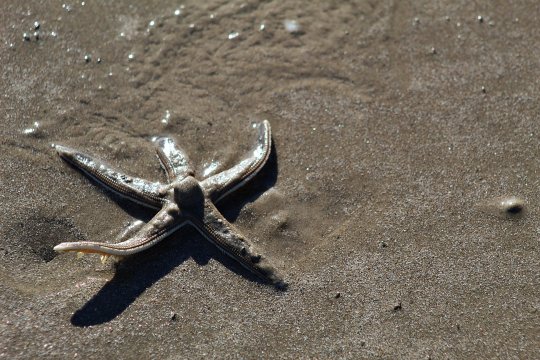
The next day we only spent the morning at Padre Island National Seashore my goodness it was amazing. One of the first creatures we met was this Gray Sea-star. You might think that old “stubby” (here what we named him for he was missing part of the top arm) was dead. I had a shovel with me in the back pocket of my pants and I scooped him up being careful not to touch him just in case I had something that might make him sick if he was alive; and sure enough by the time I got him on to my shovel he began to squirm around. I was able to take him back where he belonged and put him back in the water. My guess was that there was a feeding group the night before and he got stranded. That was my first oceanic animal rescue. I have saved baby turtles at Lake Arlington in Arlington Texas a couple of time but to be honest I don’t make that many animal rescues. I do a couple but not as many as you can think. Some time it is best to leave nature be. However I knew that more beach goers would possibly find this guy and I didn’t want him hurt anymore than he had been. It was just a judgement call I had to make on my own. I could have left him out there but I didn’t and put him back where he needed to be to feed another day.
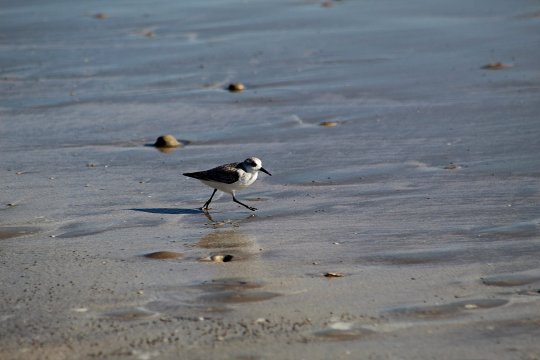
As we walked along the beach I spotted out in the distance; some Sanderlings that were out on the beach feeding in groups of around six or seven individuals. there were a bunch out there and they were all in tight bunches. I watched them as they were feeding this one deiced to feed all on his own and was moving as fast as his little legs could carry him to the next best feeding area. These guys are just a touch bigger than the Least Sandpipers that we get all the time at Lake Arlington during the winter months. That is still pretty darn tiny. These guys are totally dwarfed by humans. If you are right on them they look even smaller compared to you. They are just so cute as they scurry about the sand looking for tasty morsels in the sand. They mainly feed on Periwinkles, bugs, and some other forms of mollusk.
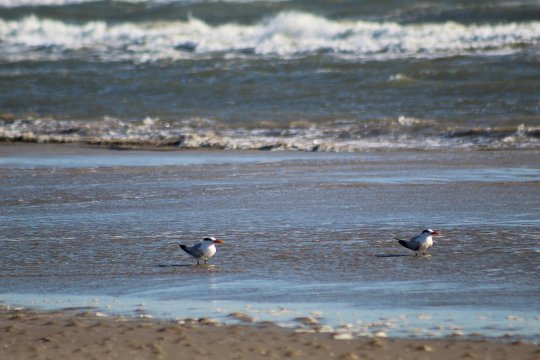
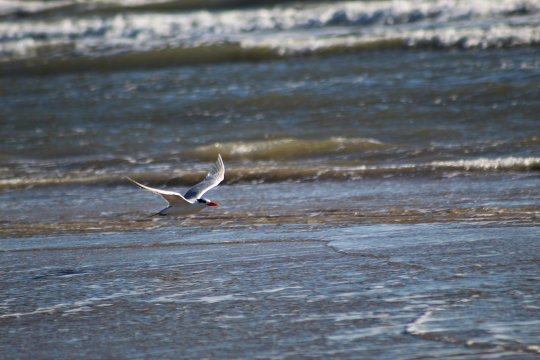
Some Royal Terns were out on the beach resting but one decided it would be best to take to the sky. Some of the in-flight shots were hard to get back when I had that Nikon Coolpix L830. I still have it and it still works but with the Canon EOS Rebel T6 it is much easier to get some of the better in-flight shots now that I have a camera with a viewfinder or what I like to call the Eye-piece. I can now lead a bird and get some of the shots that I have never been able to with just the screen. The screen was hard to use; I often lost the bird and it would hardly get into focus but with a much faster camera it gets those hard to get in-flight shots perfectly. I have only had it a couple of months now so I am still getting used to it. I had my other camera since 2015 and it took me a while to master that one. So there is a lot of stuff that I am still learning to do with this camera. Just after these shots were taken early in January at River Legacy I went and took their free camera course on how to use DSLR cameras. I really like the idea that River Legacy has that kind of class for people that have advanced cameras or who are thinking about getting an advanced camera. Some of the best things are free and that class was amazing.
I know I am going on another off track topic but still it helps to talk about other things too. So on the beach there were a few things out and about but not much. Soon the time was up on us to head back so we went to the car and went off to a souvenir shop. We love to go to shops down there and help out local businesses.
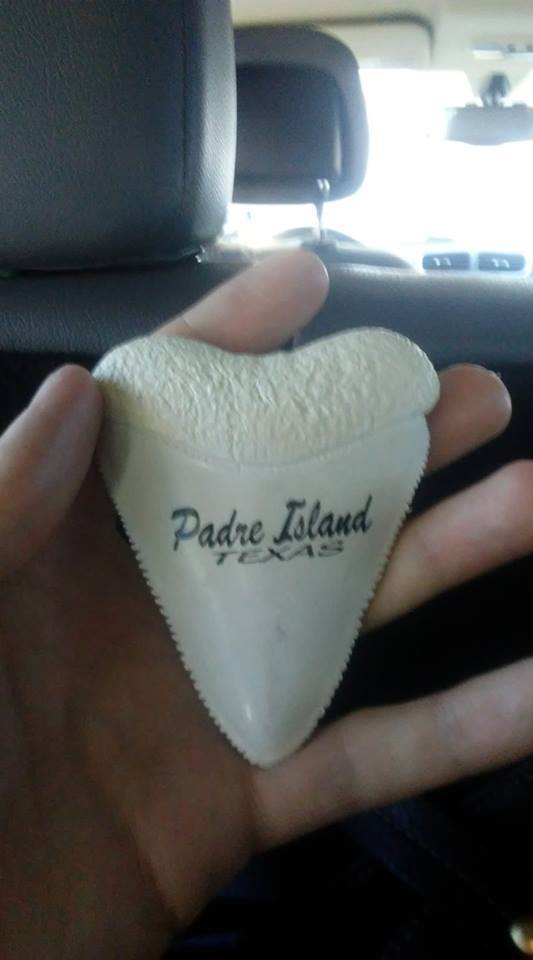
I bought this cool fridge magnet that is in the shape of a Great White Shark Tooth. I am just gaga over sharks. Ever since I saw the movie Jaws for the first time back in High School I have been totally into sharks and want to learn all I can about them. I have become quite the fan of the annual Discovery Channel Shark Week that happens every summer. I just bought a new Shark bedding set that is cool. My aunt bought me a shark bank not too long ago to spruce up my new room, I also have shark figures and toys on top of my dresser. So you can say I am a shark junkie. I also have a shark tooth necklace took. I also have a few shark shirts as well. I have the one Jaws shirt and then I have two gray button downs with hammerheads on them. My grandmother used to say to me that I dress like an old man. I do wear a lot of button downs with print on them I just like the beach style. The button down open, a tee shirt under that, the shark tooth necklace, bucket hat, and sneakers and on occasional flip flops. Normally on my adventures I wear jeans and hiking boots but sometimes it is okay just to think of waves and the island style. Still I think sharks are amazing creatures. I have always liked sticking up for the misunderstood creatures because they get such a bad reputation for being labeled as evil mindless monsters. I think that shark deserve respect and don’t deserve to be feared. People need to understand that when you go into the water you are on their territory. Human ego say this land is my land and I can go into it and everything goes my way; but in the real scheme of things humans need to learn that the water or that forest is their land and I am in their world and need to be aware that there are things that might be potentially dangerous so I need to be alert and be aware of my surroundings. Wish that is the way it is but some people just don’t understand. ----------------------------------------------------------------------------------------------------------- Anyway on the way back home we decided to stop off at innerspace Caverns to see if they had another tour but their last tour had just ended. My brother is not totally into what I am into. He is into more complex things like extinct ice age animals which I do admire a lot; he is also into video games. So there is still much work to be done with him. he doesn’t really like fossil collecting, birding, or photography like I do. No he is only into certain things. He also spends a lot of his time watching espionage films and he does like Star Wars but he is not totally into what I am in which is fine so we try our hardest to find things on trips that would appeal to him. So we decided to go back down the next day to George Town Texas and go on a tour through the cave. We also made plans to go to a place I have always wanted to go called Waco Mammoth National Monument. So we went on home but the next day we were ready for more adventure.

A shot of me about to embark on the cave tour. My goodness was this cave cool! there was a lot of neat things to see. I have not been in a cave in a long time. The last time I went to a cave was at the Cave Without a Name in Boerne Texas and that was a really long time ago. I have only been too a limited amount of caves but I am really looking forward to going to more when we have the time and the means of getting to them. The things you can see in a cave are just phenomenal. I may not be much of a geology nerd but I do find fossils, minerals, and rocks to be very cool. My family have always been Rock-hounds. We collect all kinds of rocks and things to make edging for flowerbeds, rock gardens and who knows what else. I am still trying to get a display case for all of my fossils in my collection. Right now most of my rocks and fossils are in collectors Whitman’s Chocolate Tins with some drawer liner. Hey I go for the cheap end of the deal when it comes to things. I make do with what I have and make it work. Sometimes I wish I had a tool cabinet to put them in but I have a long way to go before I can get one of those. I have to make priorities. So yeah more of my rock nerd is coming out with that last bit. I am always wanting new equipment and stuff for my nerd hobbies. Being a naturalist can be very inexpensive but when your in a little deeper you start dreaming of some bigger major league toys.
In this cave there are many interesting an beautiful rock formations to observe and to gawk at. Here are a few of my personal favorites that I was able to get good shots of. The light was very dim and it was hard to get everything in the gloomy lighting situation in that cave which was okay I still got what I wanted for the most part.
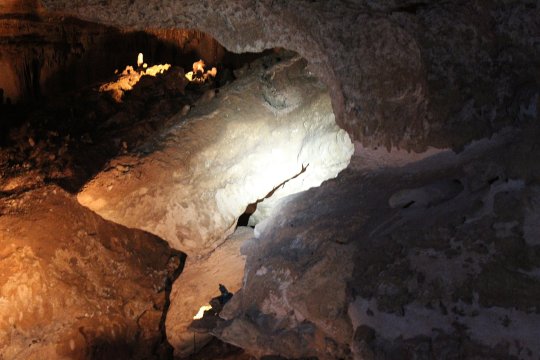
Here is one that our tour guide called the Cave Shark at a place called the imagination station. It was pretty neat how the rocks all looked like a sea theme. This Cave Shark looked as if it was coming straight out of the wall. It looks just like a shark which made me very happy as you can tell from the earlier part about the magnet. This was my personal favorite from this part of the tour.
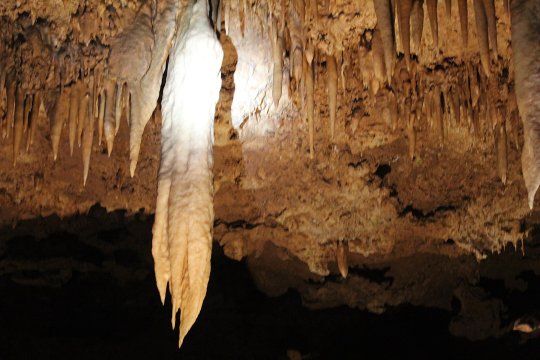
What is a cave shark without a Cave Squid? This Stalactite looks just like a Squid wouldn’t you agree? I think it does and so did our tour guide. Some of these caving guides get really creative when engaging with people about the caves while having fun along the way. Some of the people I know are not into nature one bit but my goodness they don’t know what they are missing. They totally miss out on all the cool things they could be seeing that they don’t often get to see. Traveling under ground is fun you find all kinds of funny things under there in the caves. One thing about it there is a funky smell that goes with it and the humidity too! You think caves are cool try this cave on for size you will be one sweaty hiker by the time they are done with you. I am not complaining but there is a strange aroma that comes from all the minerals and water and bat guano that really is one funky smell but we’re naturalists and we don’t mind it one bit.
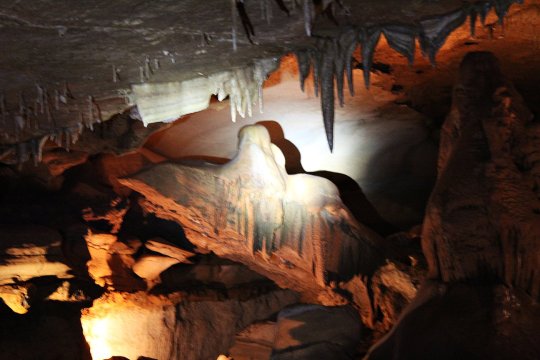
This little scene which is just off of one of the paths to the right that is really cool. It reminds me of two things the desert southwest from the Roadrunner and Wile E. Coyote cartoons or a scene straight out of Indiana Jones and the Temple of Doom like where they are first entering the Thuggee temple just after escaping the spike room which was connected to my personal favorite Indy phobia scene which was of course the bug tunnel. That scene was crazy; I find it funny how nature always bring back flashbacks of Star Trek, Star Wars, Men In Black, Jurassic Park, Pokemon, Battlestar Galactica and many other different show and movies. I am sorry I can’t go a day without making some crazy reference to something. I guess when you are a nerd it is what you do. I don’t just think of science fiction and nature for nothing. Their is a reason why I call myself Galactic Bugman on some things and then Galactic_Naturalist on others for nothing. Those my are my prominent two obsessions nature and science fiction and cartoons. So there a big reason why I make that my screen name for many things. It is just who I am and that is my story and I am sticking to it.
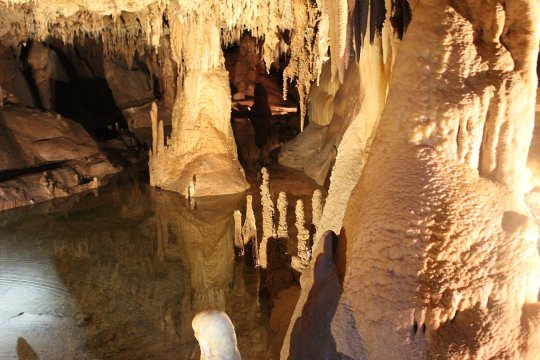
Checkout this beautiful room right here! Ah the glorious Lake of the Moon. Okay that sounds a lot like a Pokemon Sun and Moon reference to me. The place where you get Lunala. I know again with the crazy references. Anyway this room really had me at first sight. It is amazing and so beautiful. The water is so clear and the formations are just so wonderful to see. If you go you have to take the easy tour in order to see this thing of beauty. This was the highlight of that tour. The shark totally got blown out of the water with this one (Hint: that was a Jaws Reference) the shark was pretty Jawsome! (Okay everyone hates puns I get it) but this was even more astounding. This was a really nice room of the cave. I am so glad I got to see this natural wonder and get it all on camera. Just look at some of those reflections that is how clear the water was! My golly it was amazing.
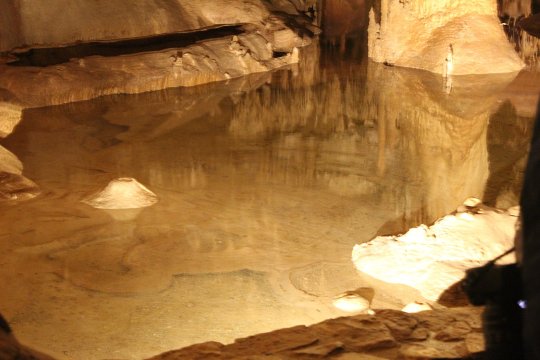
Another shot of just the water at the Lake of the Moon before we all turned around and headed back to the mouth of the cave. It this trek was pretty fantastic. I will have to make another trip out there and do one of the more advanced hikes which would require more squeezing into tight spaces and other things but heck I have always wanted to do some spelunking just too see what I could find and gain some more new memories and put some more experience points under my belt.
We eventually made it back to the gift shop and I bought two things at this stop and boy where they neat.
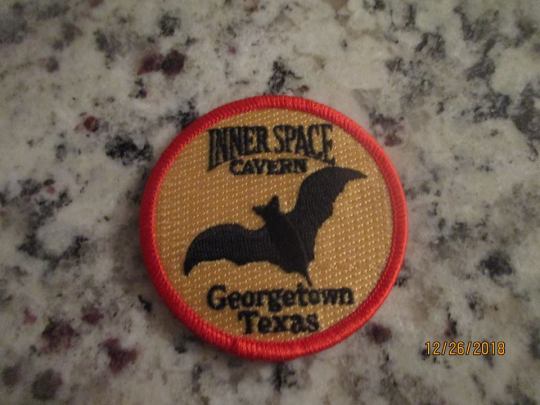
I got this neat patch for my vest that I was wearing that day in fact.
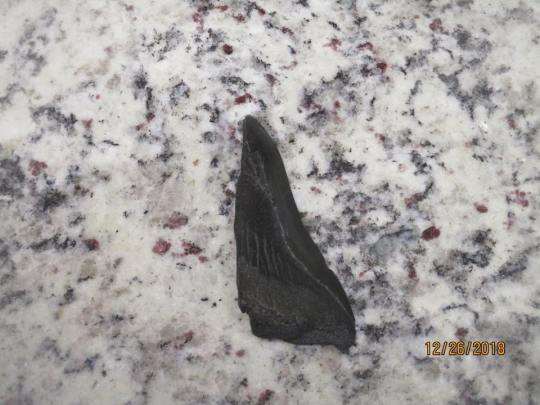
And my new favorite fossil to my collection which is the partial tooth fragment of a Megalodon. These things can go for so much more other places but this fragment only cost me twenty bucks which was not a bad price for one of these suckers. It is a pretty good sized piece of a tooth. It is also in really good condition even if it is just half of a fossilized tooth. I am not complaining I saw this and I was like yep that would make a good conversation piece to have in my collection. So again with the shark stuff. I am just bonkers about such things but heck that is what makes me, me. You can either take it or leave it.
So the next thing on our Whirlwind tour around Texas we went to the Waco Mammoth National Monument. This was a great place to go for my brother. Both the cave and the Waco Mammoth site were good places for my brother for he really liked them a lot. As for me I was totally in science la la land. It had felt like I had stepped into the TARDIS and went back in time to a time when everything was different than today’s world.
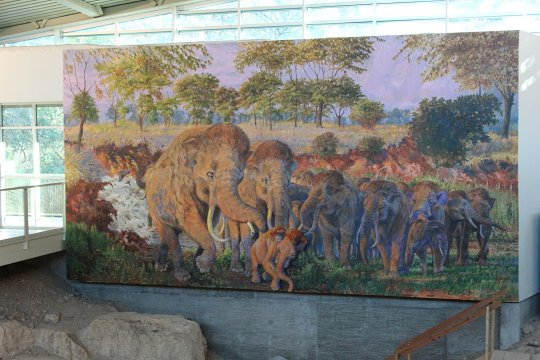
When you go inside the building that protects the site you don’t quite know what you are going to expect when you walk in. This was the first thing I saw just before I saw the massive bone pile that was in this building. This mural shows what may have transpired on this site thousands of years ago. The story this site tells is of a flood that came through the land trapping a nursery heard of Columbian Mammoths, and a few other creatures like a Prehistoric Camel (Yes we did get a species of extinct camel in Texas at one point. It sounds a little far fetched but heck there was even Giant Ground Sloths at one point) and a few Saber Cat. Notice how some paleontologist say Saber Cat that is because calling them Saber Toothed Tiger is wrong because they are not anywhere nearly related to the Tigers of today. Not trying to be critical I am just saying you will hear this a lot from people like them.
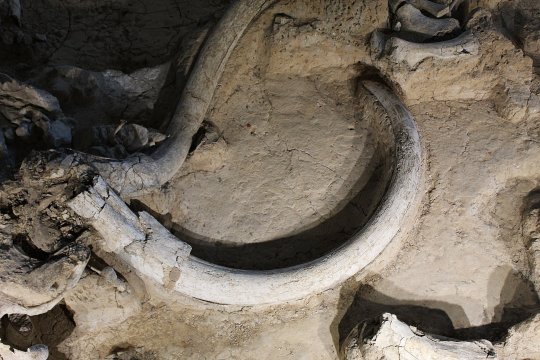
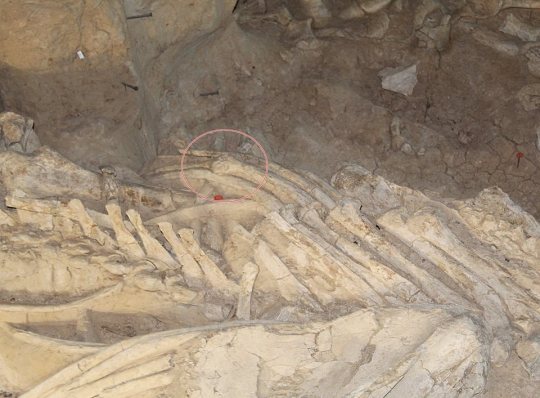
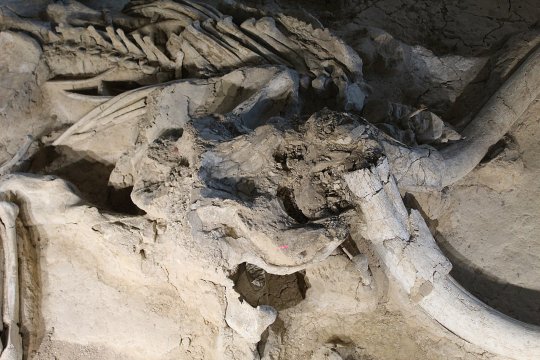
Okay so the bones shown here are from the only male found on the site. His official name is Mammoth Q or as a term of endearment they call this big fellow Quincy. This guy has quite the story to tell. Look how big and massive his tusks are. They are amazing to look at but you notice that his skull has been totally smashed and crushed in the bottom picture. This is really dramatic and this must have been one heck of a bad way to go down. They say that he must have gotten stuck in the raising waters and fell and in the panic of all the other animals trying to get to safety that his head got trampled on and crushed. You can kind of make out somewhat of a footprint shape. Notice that I circled something rather interesting in the rib cage of this animal. There is a knot in his bone. They said that he might of got that while fighting and may have been a cause of illness for it not healing right and that weakened him but we don’t really know for sure. That is all paleontology is the science of prehistoric forensics and speculation! Still a very neat set of fossils if I do say so myself. This guy was quite massive.
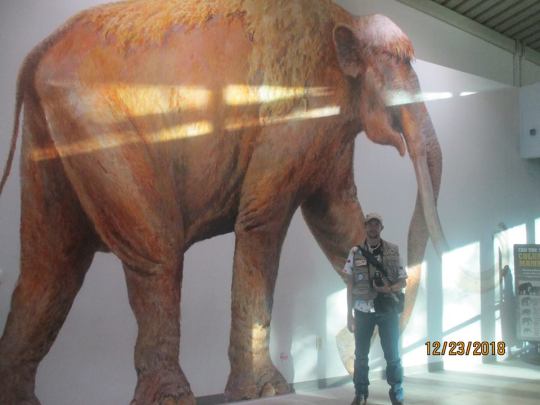
Here is a mural to give a rough estimate of what Quincy could have looked like. It is not to full scale the mural should be a few inches taller but the lights got in the artist’s way. Notice that he hair on his body looks much like the hair of an American Bison. It could have very much been the same for of the moderate temps of that time period to keep him warm at night but to not be too hot in the summer time. Remember these are not Woolly Mammoths so they didn’t need a lot of hair on their bodies since we did have a lot of moderate temps. And just look at that size. I am so glad this is just a painting and not the real McCoy or I could run the risk of getting flattened like a pancake standing this close to this guy. I knew elephants are big but my gosh they make me look tiny. Still a pretty good size comparison if you ask me. I like that the artist had some sense of humor and gave him a Three Stooges Moe hairdo or just a Chili bowl hair cut. It think that is kind of funny even though he probably didn’t look a think like one of the Three Stooges but heck I think that artists need to have a little fun while doing their job. I love added flair to artist representation.

Here is another Mammoth that they have on site. This one is called Mammoth W or Wanda. She is one of the oldest females that was part of this heard. One of her tusks was removed to keep it from getting damaged further. Some of these bones are very fragile and had to be treated with kid-gloves. Still another fascinating animal to look at as the guide showed her to us. When I am dealing with a fossil site if it is one I am allowed to dig on or like this it doesn't really matter which; I always try to imagine myself at the exact same time period as these creatures were. My representations may not be as accurate as how they sound in my mind but I always try to picture how life must have been for the creatures by visualizing the animals of today and then thinking back further to these guys and try to visualize them doing what they did to survive like how they may have hunted or how they did other things. As Captain Jean Luc Picard said on Star Trek First Contact “Sometimes touch came make something more real.” I believe that a lot. Now I was not able to touch these fossils but I went out to Mineral wells Fossil park a few years back and was able to touch the fossils and feel of them and that gave me more a visual aid and a better understanding. Sometimes it is hard but study the landscape and the topography and listen even you can hear faint echos of the past like a distant cry from earth’s past. You can almost feel what they must have been going through. When I first walked into this place I was blown away. It was almost like the reaction Ellie Sattler, and Alan Grant gave when they saw their first live Brachiasaurus. It was almost like that except they were just the skeletons of what was once living. It took me back to a place that I could only dream of touching. I is very moving to be in a place like this and to feel how life was then. Sometimes if you let your imagination work with you when experiencing places like this you will get a better understand of how life was back when things were a little bit different.
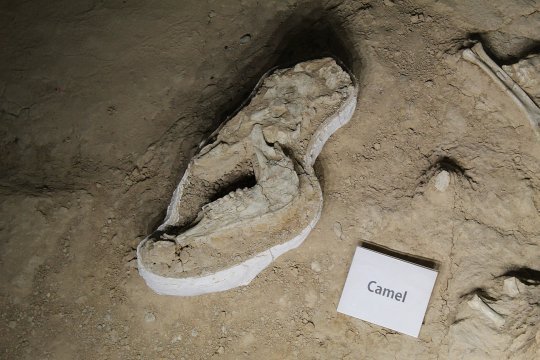
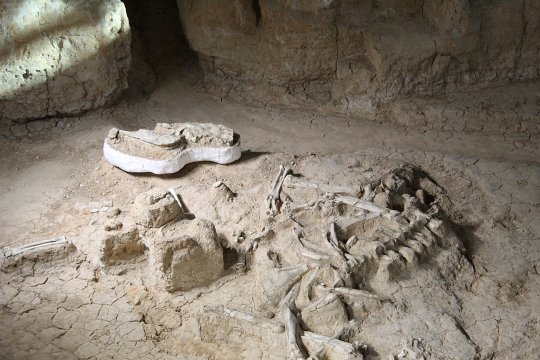
This was the only known Camel on site that they found. Poor Flood which is what they named her was all broken up and scattered. Her bones were not intact and were just in a pile. Her skull had to be moved back with the rest of her. It may seem kind of funny (not ha ha funny) but just kind of odd that they would do that. This site is still being excavated for more fossils and they have a lot more to do once they get a paleontologist on board. So who knows what they will uncover next. This concludes my winter vacation posts. I hope you enjoyed my photos I took and I hope you had fun reading about my experiences and I hope that you will start you own nature adventure and explore the world of nature like I am currently doing. It is amazing to see new things and travel to wonderful places. I think that nature is very important and I will continue to write more about my life’s experiences on this blog site to help inspire and give you a little window of my life and how crazy cool it can be. I may not be an expert but I don’t have a problem writing myself field notes and sharing them with you. I hope you will continue reading my blogs and following my material. I am opening this Blog up to not just insects but to birds, mammals, reptiles, amphibians, fossils, and everything that is nature. Until then take care of yourself and I will see you on the trail.
#texas coast#caves#mammoths#prehistoric#nature#wildlife#fun#winter#trip#2018#texas#georgetown tx#animals#birds#birding
0 notes
Text
Green-haired turtle that breathes through its genitals added to endangered list
With its punky lettuce mohican the striking Mary river turtle meets a new ZSL list “of the worlds” most disadvantaged reptiles

It sports a green mohican, fleshy finger-like swellings under its chin and can breathe through its genitals.
The Mary river turtle is one of the most striking animals on the planet, and it is also one of the most endangered.
The 40 cm long turtle, which is only found on the Mary river in Queensland, features in a new register of the most vulnerable reptile categories compiled by the Zoological Society of London( ZSL ).
Despite the turtle’s punk image- is coming from vertical filaments of algae that too change on its body- its submissive nature impelled it historically popular as a pet.
Gill-like organ within its cloaca- an orifice are exploited by reptiles for excretion and mating- enable it to bide underwater for up to three days, but it was unable to hide from the pet collectors who attacked its burrows during the 1960 s and 1970 s.
The turtle is placed at 30 th on ZSL’s Evolutionarily Distinct and Globally Endangered( Edge) schedule for reptiles. First established in 2007, Edge registers have previously been published for amphibians, birds, corals and mammals, helping guide conservation priorities for 100 most at-risk species. Each species is given a orchestrate which mixes extinction jeopardy with its evolutionary withdrawal or uniqueness, with the most recent register supported by a study in the magazine Plos One.
Top of the list is the Madagascar big-headed turtle, which has an Edge score higher than that of any other amphibian, fowl or mammal, and is still made for nutrient and world trade.
Other unique and endangered species include the Round Island keel-scaled boa from Mauritius, a serpent which is the only terrestrial vertebrate known to have a hinged upper mouth; the hour leaf chameleon from Madagascar which is the size of a human thumbnail; and the gharial, a slender-snouted fish-eating freshwater crocodile. Less than 235 gharial exist in the rivers of northern India and Nepal.
The Mary Rriver turtle is one of “the worlds largest” dazzling animals on countries around the world, and it is also one of the most endangered.
Rikki Gumbs, co-ordinator of Edge reptiles, added:” Reptiles often receive the short demise of the stick in protection words, compared with the likes of fledglings and mammals. However, the Edge reptiles index highlightings just how unique, susceptible and amazing these men truly are .”
He included:” Just as with tigers, rhinos and elephants, it is necessary to we do our utmost to save these unique and too often forgotten swine. Many Edge reptiles are the sole survivors of archaic ancestries, whose sprigs of the tree of life stretching back to the age of the fossils. If we lose these species there will be nothing like them left on Earth .”
Read more: https :// www.theguardian.com/ medium/ 2018/ apr/ 11/ green-haired-turtle-that-breathes-through-its-genitals-added-to-endangered-list
0 notes